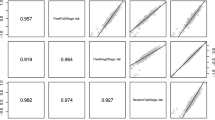Abstract
Variance componentsare quantities of central interest in many applications, e.g., in cultivar yield stability analysis and in the analysis of measurement errors. In some applications, the feasible sample size is rather limited, leading to estimates of variance components that are subject to considerable sampling variation. For example, new crop cultivars are tested in only a few environments before release to the market, so the sample size for the variance across environments is small. Similarly, testing a new measurement instrument for some chemical compound may be costly, allowing only a limited number of replications. This article investigates the potential for improving the usual sample variance estimator by exploiting covariate information. In a cultivartrial, yield data may be available for only a few environments while meteorological data or data on a standard cultivar has been recorded for a very large number of environments. Likewise, in the analysis of measurement errors, there may be long-term data on a standard measurement procedure that can be used as a covariate to improve the variance estimate for a new instrument. It is shown in this article that the gain in accuracy achieved by using a covariate can be considerable, provided there is sufficient correlation between the covariate and the variable of interest.
Similar content being viewed by others
References
Cox, D. R., and Hinkley, D. V. (1974), Theoretical Statistics, London: Chapman & Hall.
Dunn, G. (1989), Design and Analysis of Reliability Studies, London: Edward Arnold.
Fuller, W. A. (1987), Measurement Error Models, New York: Wiley.
Hocking, R. R. (1976), “The Analysis and Selection of Variables in Linear Regression,” Biometrics, 32, 1–10.
Jaech, J. L. (1985), Statistical Analysis of Measurement Errors, New York: Wiley.
Johnson, N. L., and Kotz, S. (1970a), Continuous Univariate Distributions (vol. 1), New York: Wiley.
— (1970a), Continuous Univariate Distributions, (vol. 2), New York: Wiley.
Piepho, H. P. (1998), “Methods for Comparing the Yield Stability of Cropping Systems—A Review,” Journal of Agronomy and Crop Science, 180, 193–213.
Piepho, H. P., Denis, J. B., and van Eeuwijk, F. A. (1998), “Predicting Cultivar Differences Using Covariates,” Journal of Agricultural, Biological, and Environmental Statistics, 3, 151–162.
Searle, S. R. (1982), Matrix Algebra Useful for Statistics, New York: Wiley.
— (1987), Linear Models for Unbalanced Data, New York: Wiley.
Searle, S. R., Casella, G., and McCulloch, C. (1992), Variance Components, New York: Wiley.
Stuart, A., and Ord, K. (1991), Kendall’s Advanced Theory of Statistics (Vol. 2), London: Edward Arnold.
Author information
Authors and Affiliations
Corresponding author
Rights and permissions
About this article
Cite this article
Piepho, HP., McCulloch, C.E. Can the sample variance estimator be improved by using a covariate?. JABES 7, 157–175 (2002). https://doi.org/10.1198/10857110260141210
Received:
Accepted:
Issue Date:
DOI: https://doi.org/10.1198/10857110260141210




